Report of the Mikhail Khazin Foundation for Economic Research
Table of Contents
1. Root causes of the crisis. The fading of the liberal economic model
2. Inflation and actual economic performance
3. The US real sector and the global financial elite, their position and interests during the crisis
4. Modelling the results of the plans
5. Resolution
Data source
1. Root causes of the crisis. The fading of the liberal economic model
By the 1970s, the natural development resource of the Bretton Woods model, laid down in 1944, had been completely depleted. Lending through the Bretton Woods institutions (IMF and the World Bank), the enforcement of GATT rules (the future WTO) and other mechanisms has exhausted their reach in the US-controlled part of the world economy. As a result, on August 15, 1971, the United States was forced to abandon the pegging of the dollar to gold, and the crisis of the 1970s began. It is not easy to assess this crisis, as statistical techniques have changed several times since then. Analysis by the Khazin Foundation shows that the 1970s were a period of constant economic decline in the “western” (i.e., subordinate to the Bretton Woods model) division of labor.
Based on the theory we are developing (see M. Khazin “Crisis of capital effectiveness”, 2020), there were only two ways out of this situation: either expansion of the “western” system of division of labor, or initiation of “non-economic” (that is, by artificial, emission resources) stimulating demand. Of these two variants, the second was chosen, historically known as “Reaganomics” (which, however, was prepared under President Carter of the United States) because in the 1970s the Soviet system of division of labor on the basis of the resources of the USSR was unshakeable.
The essence of the “Reaganomics” model was to stimulate private demand by refinancing household debt against ever-declining credit rates. In 1981, the US Federal Reserve’s discount rate was 18%, but by 2008 it had dropped to zero. Probably, the crisis would have happened earlier, but in the late 1980s the Soviet system of division of labor collapsed, giving the western (and since 1991 – world) economy about 10 years of respite (the so-called “golden age” of Clinton), due to the sharp increase in the number of consumers. This point can be clearly seen on the chart of the interest rate (fig.1), which in the 1990s temporarily stopped its decline.

The 2008 crisis has shown that this resource has also dried up. For some time, the US Federal Reserve has been printing money, supplying the budget with it and filling gaps in the banking system, and this resource is still in use today, but it is close to exhaustion. You can read more about the situation in the above-mentioned book by M. Khazin, but in this report we review the current situation in the US economy.
In any case, our starting point is the continuation of the acute crisis in the US economy. It is not possible to stop the economic downturn. At the same time, the liberal economic model, built according to the logic of “Reaganomics” for more than 10 years has showed that it is unable to ensure economic growth. If we stop fueling demand financially, this transition will begin immediately, and the effectiveness of the emission stimulus is constantly declining, which requires an ongoing increase in the capacity of the printing press.
During the 2020-2021 pandemic, extensive quarantine measures were carried out in various countries. Large segments of the population did not work or worked remotely, causing a significant decline in production. In fact, the downturn masks a true crisis that should have begun later. However, the COVID-19 factor, which did not fit into the standard economic order, catalyzed the development of expected events. Quarantine actions simply triggered a structural crisis in the world economy, similar to the crisis of 1930-32, which led to the Great Depression. For these reasons, as we warned earlier, a rapid economic recovery cannot be expected.
Because liberal (mainstream) economic theory does not describe structural crises, the Bretton Woods institutions and policymakers have tried to create a sense of an imminent return to early-year indicators. Expectations of an early end to the recession and recovery failed – growth virtually ceased by the end of summer 2020. In the current situation, the world economy is returning to recession without recovering from previous shocks. This is fully consistent with our ideas, and the main advice that we can give our readers is to assume that there will be no economic growth in the coming years.
The full text of the report will be available after payment
15000 rub.

